

1. What is a low bed semi trailer used for in Philippines?
2. What is another name for low bed semi trailer in Philippines?
3. How to Drive a Low Bed Semi Trailer in Philippines?
4. Operation of 3 types of Low Bed Trailer Ramps
4.1. Operation of Spring Ramps
4.2 Operation of Folding Ramps
4.3 Operation of Hydraulic Ramps
Transportation is a crucial aspect of economic development and infrastructure growth in any country. In the Philippines, with its vast and diverse geography, the efficient movement of goods and heavy equipment plays a pivotal role in various industries. Low bed semi-trailers, also known as lowboy trailers, have emerged as indispensable assets in the transportation sector. In this article, we delve into the applications of low bed semi-trailers in the Philippines and explore the key industries that rely on their capabilities.
1. Construction and Infrastructure Development:
The construction industry in the Philippines has experienced remarkable growth in recent years, with numerous infrastructure projects underway across the country. Low bed semi-trailers play a vital role in transporting heavy machinery, such as excavators, bulldozers, cranes, and loaders, to construction sites. Due to their low deck height, these trailers facilitate the transportation of tall and oversized equipment, ensuring safe and efficient movement on the often challenging road network.
2. Mining and Quarrying:
The Philippines is rich in natural resources, particularly minerals and ores. The mining and quarrying industry heavily relies on low bed semi-trailers to transport heavy equipment used in extraction, such as large drills, rock crushers, and earthmoving machinery. These trailers' robust design and weight-bearing capacity make them ideal for transporting massive loads over long distances, including navigating rugged terrain encountered in mining operations.
3. Energy and Power Generation:
With the country's increasing demand for electricity, the energy and power generation sector has witnessed significant expansion. Low bed semi-trailers are essential in this industry for the transportation of heavy equipment, such as power transformers, generators, and turbine components. Given the oversized and sensitive nature of these components, low bed trailers offer the necessary stability, load distribution, and maneuverability to ensure their safe delivery to power plants and installation sites.
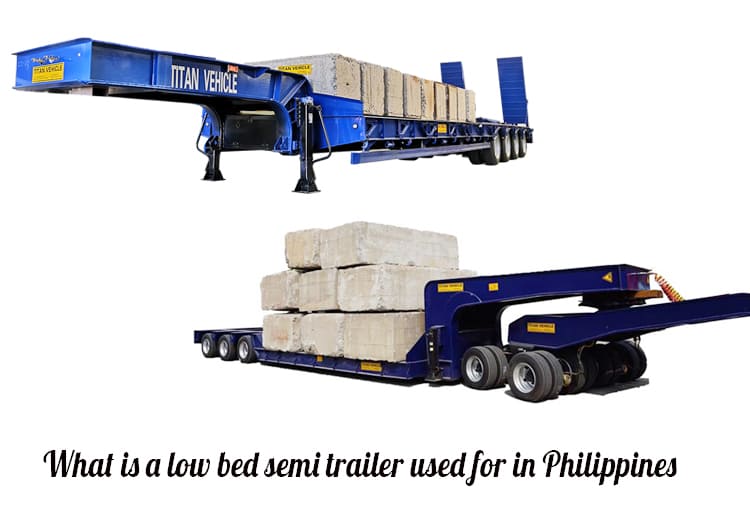
What is a low bed semi trailer used for in Philippines
4. Agriculture and Forestry:
The agricultural and forestry sectors in the Philippines rely on various heavy machinery and equipment to support efficient operations. Low bed semi-trailers provide a practical solution for transporting agricultural machinery like combine harvesters, tractors, and large irrigation systems. Similarly, in the forestry sector, these trailers enable the movement of logging equipment, such as skidders and harvesters, facilitating efficient timber extraction and transportation.
5. Heavy Haulage and Transport:
Apart from specific industries, low bed semi-trailers serve a general-purpose role in heavy haulage and transportation. They are commonly used to transport oversized cargo, prefabricated structures, industrial equipment, and other large objects that cannot be accommodated by regular trailers. Their low deck height, extendable ramps, and ability to handle high weight capacities make them ideal for such transportation needs, ensuring secure and timely deliveries.
In the Philippines, low bed semi-trailers have become indispensable in various industries, catering to the transportation needs of heavy machinery and oversized cargo. From construction and mining to energy and agriculture, these trailers facilitate the efficient movement of equipment, contributing to the growth and development of the nation's infrastructure and economy. As the country continues to invest in key sectors, the demand for low bed semi-trailers is expected to rise, reinforcing their vital role in the transportation landscape of the Philippines.
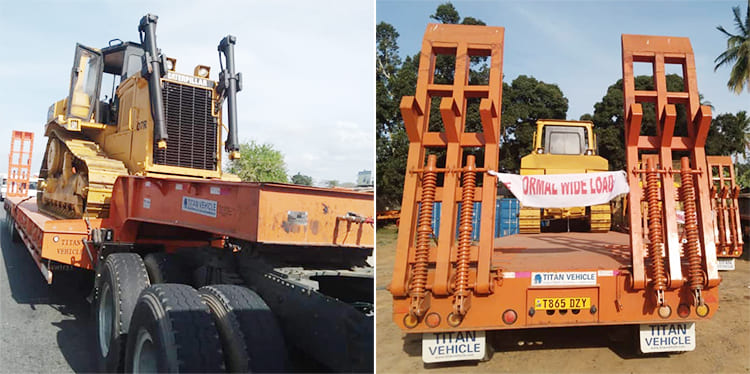
What is a low bed semi trailer used for in Philippines
The transportation and logistics industry is an essential component of any thriving economy. In the Philippines, where diverse terrains and challenging topographies abound, the need for specialized trailers is paramount. One such type of trailer that plays a crucial role in transporting heavy equipment and oversized cargo is the low bed semi-trailer. However, as with any industry, local terminologies and jargon often emerge. In this article, we delve into the regional adaptations and alternative names used for low bed semi-trailers in the Philippines.
Understanding Low Bed Semi-Trailers:
Before we explore the Filipino terminology, let's first define what a low bed semi-trailer is. A low bed semi-trailer, also known as a lowboy trailer, is a specialized type of trailer designed to transport heavy and oversized cargo. It features a low height, which allows for the efficient transportation of tall and heavy loads, such as construction machinery, industrial equipment, and other large items. These trailers typically have a detachable front section, referred to as the "gooseneck," which allows for easy loading and unloading of cargo.
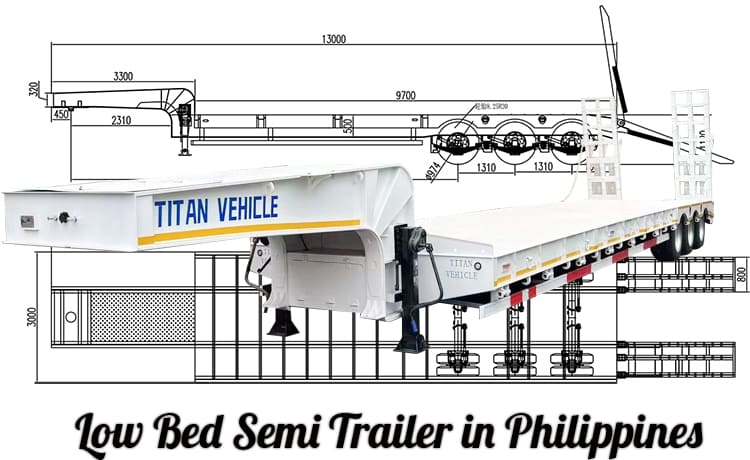
What is another name for low bed semi trailer in Philippines
The Filipino Adaptation:
In the Philippines, low bed semi-trailers are commonly referred to by a unique local term: "litsong truck." This name, while not officially recognized in standard English or other global transportation industries, has gained popularity and acceptance within the Philippine context. The term "litsong truck" is derived from the Filipino word "litsong baboy," which translates to "roast pig" in English. The association with roasted pig likely arises from the image of a low bed semi-trailer that tilts or "roasts" when loading or unloading cargo.
The usage of "litsong truck" has permeated various sectors involved in heavy cargo transport, including trucking companies, logistics providers, and even individuals working in construction and engineering fields. It has become a vernacular term used colloquially across the archipelago, even though it may not be widely recognized outside the Philippines.
Regional Variations:
While "litsong truck" serves as a common term, it is worth noting that regional variations in naming also exist. The diverse linguistic landscape of the Philippines has contributed to the emergence of different localized names for low bed semi-trailers. For instance, in some regions, these trailers are referred to as "trayler," a term derived from the English word "trailer" but pronounced in a distinct local accent.
In other areas, low bed semi-trailers are known as "dropside trucks" or "flatbed trucks," emphasizing the characteristic low height and open-platform design of the trailers. These names highlight specific features of the trailers rather than providing an entirely unique designation.
In the Philippines, the low bed semi-trailer, a crucial asset in the transportation of heavy and oversized cargo, has acquired its own local terminologies. The widely used term "litsong truck" has become a popular colloquialism, capturing the imagination and creativity of Filipinos in describing this specialized trailer. While regional variations exist, the overarching goal remains the same: to efficiently transport heavy loads across the diverse terrain of the archipelago.
Understanding these localized names and regional adaptations allows for clearer communication within the local transportation and logistics industry. Moreover, it showcases the adaptability and ingenuity of Filipinos in appropriating foreign terms and shaping them to suit their unique context. As the industry continues to evolve, it is essential to acknowledge and embrace these linguistic nuances, as they reflect the rich cultural tapestry of the Philippines and its people's resourcefulness in everyday life.
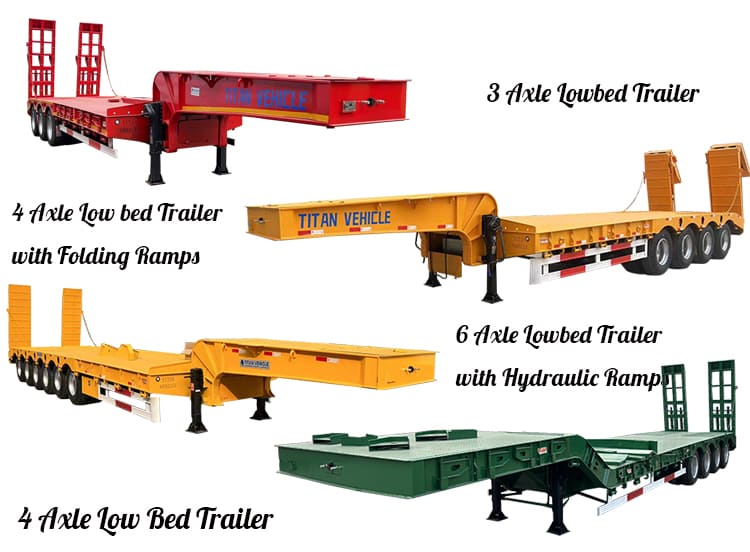
What is another name for low bed semi trailer in Philippines
Driving a low bed semi-trailer in the Philippines requires skill, caution, and an understanding of the unique challenges presented by the country's diverse terrain and road conditions. These specialized trailers are designed to transport heavy equipment and oversized cargo, making them an integral part of the transportation and logistics industry. In this article, we will provide a comprehensive guide on how to drive a low bed semi-trailer in the Philippines, covering important considerations, safety measures, and best practices.
1. Obtain the Appropriate License:
Before embarking on the journey of driving a low bed semi-trailer, it is essential to obtain the appropriate driver's license. In the Philippines, a Professional Driver's License (PDL) is required to operate vehicles weighing over 4,500 kilograms. Ensure that your license is valid and up to date, and that you have the necessary endorsements for driving heavy vehicles.
2. Familiarize Yourself with the Trailer:
Low bed semi-trailers have unique features and operational characteristics. Before hitting the road, take the time to familiarize yourself with the specific trailer you will be driving. Understand its dimensions, weight capacity, braking system, and any additional features such as hydraulic ramps or stabilizers. Ensure that the trailer is properly connected to the tractor unit and all safety mechanisms are in place.
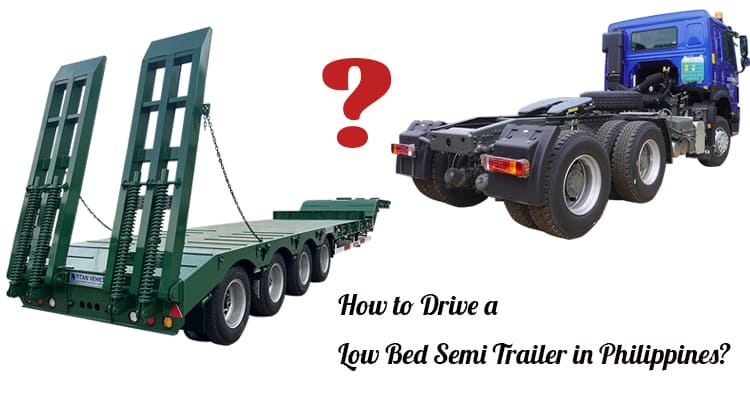 How to Drive a Low Bed Semi Trailer in Philippines
How to Drive a Low Bed Semi Trailer in Philippines
3. Plan Your Route:
When driving a low bed semi-trailer, it is crucial to plan your route in advance, considering factors such as road conditions, traffic congestion, and the presence of low bridges or underpasses. Take into account the dimensions of the trailer and choose roads that can accommodate its size and height. Be aware of any weight restrictions on certain roads or bridges to avoid potential violations.
4. Practice Safe Loading and Unloading:
Loading and unloading cargo on a low bed semi-trailer require careful attention to ensure stability and safety. Follow proper loading procedures, securing the cargo with appropriate tie-downs, chains, or straps. Distribute the weight evenly to maintain balance and prevent excessive strain on the trailer's axles. Communicate with the crew responsible for loading and unloading to ensure a smooth and coordinated process.
5. Exercise Caution on Challenging Terrains:
The Philippines presents diverse terrains, ranging from mountainous regions to coastal areas. When driving a low bed semi-trailer, exercise caution and adapt your driving style to the specific terrain you encounter. Take extra care when navigating steep slopes, sharp turns, or uneven surfaces. Use lower gears and engage the trailer's braking system to maintain control and prevent accidents.
6. Stay Vigilant and Follow Traffic Rules:
Maintaining vigilance on the road is crucial for safe driving. Pay attention to traffic signs, signals, and road markings, and adhere to the speed limits imposed for vehicles of your size and weight. Keep a safe distance from other vehicles, especially in congested areas, and use your mirrors effectively to monitor surrounding traffic.
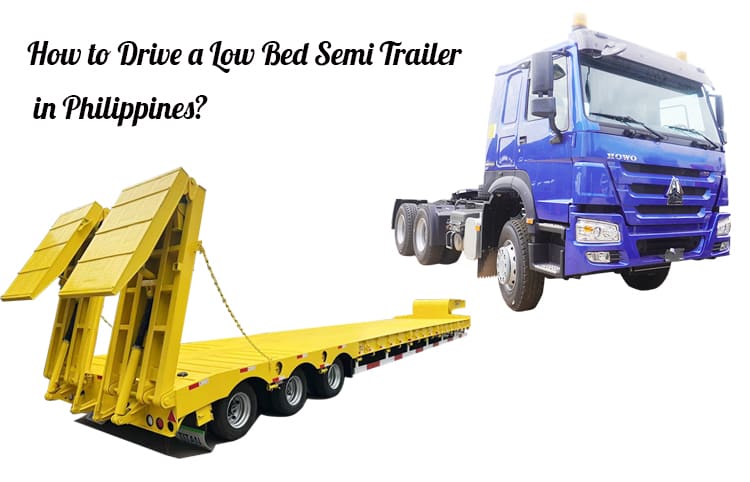 How to Drive a Low Bed Semi Trailer in Philippines
How to Drive a Low Bed Semi Trailer in Philippines
7. Be Prepared for Emergencies:
No matter how cautious you are, unforeseen circumstances can arise. Always carry necessary safety equipment, including warning triangles, fire extinguishers, and basic tools for minor repairs. Stay informed about emergency contact numbers and nearby service stations along your route.
Driving a low bed semi-trailer in the Philippines requires a combination of technical skills, situational awareness, and adherence to safety protocols. By obtaining the appropriate license, familiarizing yourself with the trailer, planning your route, practicing safe loading and unloading, adapting to challenging terrains, following traffic rules, and being prepared for emergencies, you can navigate the roads with confidence and ensure the secure transportation of heavy cargo.
Remember, safety should always be your top priority. Regularly assess road conditions, update your knowledge of traffic regulations, and stay informed about any changes or developments in the transportation industry. With the right skills, knowledge, and a responsible mindset, you can master the art of driving a low bed semi-trailer and contribute to the efficient and safe movement of goods in the Philippines.
Low bed trailers are essential for transporting heavy equipment and oversized cargo, and ramps play a crucial role in facilitating the loading and unloading process. There are various types of low bed trailer ramps available, each offering distinct features and benefits. Here are three common types of low bed trailer ramps: hydraulic ramps, spring ramps, and folding ramps.
Low bed trailer ramps come in various types, each catering to different needs and requirements. Hydraulic ramps offer efficient and independent operation, providing excellent flexibility and control. Spring ramps provide mechanical assistance, reducing physical effort while maintaining affordability. Folding ramps are convenient for trailers with limited storage space, offering easy deployment and space-saving benefits. Understanding the features and benefits of each type of ramp allows trailer operators to choose the most suitable option for their specific cargo and operational needs.
Now let's see how to operate these ramps!
Hydraulic ramps offer a convenient and efficient solution for loading and unloading heavy equipment. Follow these steps to operate hydraulic ramps effectively:
Step 1: Ensure Proper Setup:
Confirm that the trailer is parked on level ground and the hydraulic system is engaged.
Ensure the ramp sections are securely fastened to the trailer and properly aligned for operation.
Step 2: Activating the Hydraulic System:
Locate the hydraulic controls, which are usually located near the front of the trailer.
Activate the hydraulic pump or power source to raise the ramp sections.
Pay attention to any safety locks or mechanisms that may need to be disengaged before operation.
Step 3: Adjusting Ramp Sections:
Hydraulic ramps allow for independent operation of each ramp section.
Use the hydraulic controls to adjust the height of each ramp section as needed, accommodating uneven terrain or cargo requirements.
Ensure that all ramp sections are aligned and leveled for safe loading and unloading.
Step 4: Loading and Unloading:
Follow proper loading and unloading procedures, ensuring the cargo is securely fastened and balanced on the ramp sections.
Monitor the ramp sections during the process to ensure stability and make any necessary adjustments using the hydraulic controls.
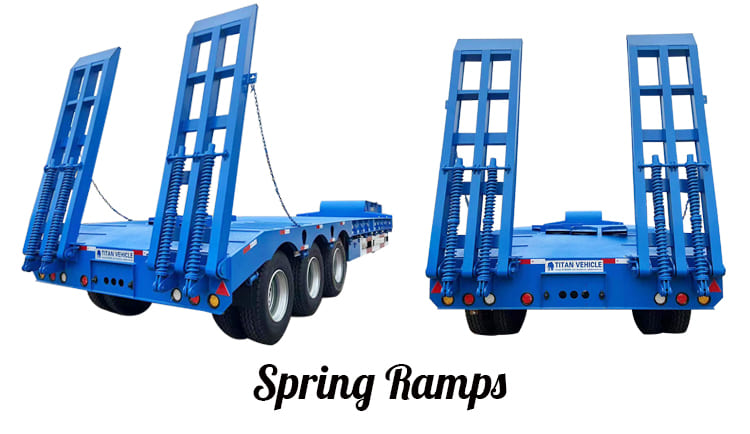 Operation of low bed semi trailer spring ramps
Operation of low bed semi trailer spring ramps
Spring ramps offer a mechanical-assisted solution, making them easier to operate compared to manual ramps. Here's how to operate spring ramps effectively:
Step 1: Preparing the Ramps:
Ensure that the spring ramps are securely attached to the trailer and properly aligned.
Check for any safety locks or latches that need to be released before operation.
Step 2: Unlocking the Ramps:
Locate the release mechanism, usually in the form of a lever or latch.
Activate the release mechanism to unlock the ramps and initiate the assisted deployment.
Step 3: Deploying the Ramps:
Apply gentle pressure to the ramps, allowing the mechanical assistance of the springs to assist in lowering the ramp sections.
Gradually extend the ramps until they reach the desired position for loading or unloading.
Step 4: Loading and Unloading:
Follow safe loading and unloading procedures, ensuring the cargo is properly secured on the ramp sections.
Monitor the ramps' stability during the process and engage any safety locks or latches once the ramps are in the desired position.
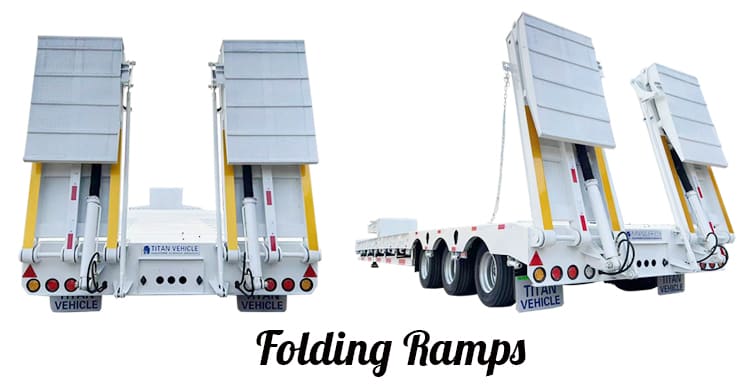
Operation of low bed semi trailer folding ramps
Step 1: Unfolding the Ramps:
Identify the folding points and hinges on the ramps.
Carefully unfold the ramp sections, ensuring they are securely locked into place.
Confirm that all hinges and connections are properly aligned for safe operation.
Step 2: Adjusting the Ramps:
Position the ramps at the desired angle for loading or unloading, ensuring they are stable and secure.
Some folding ramps may have adjustable settings or locking mechanisms to hold them in place.
Step 3: Loading and Unloading:
Follow proper loading and unloading procedures, paying attention to the stability and weight distribution on the ramp sections.
Monitor the ramps during the process to ensure they remain secure and functional.
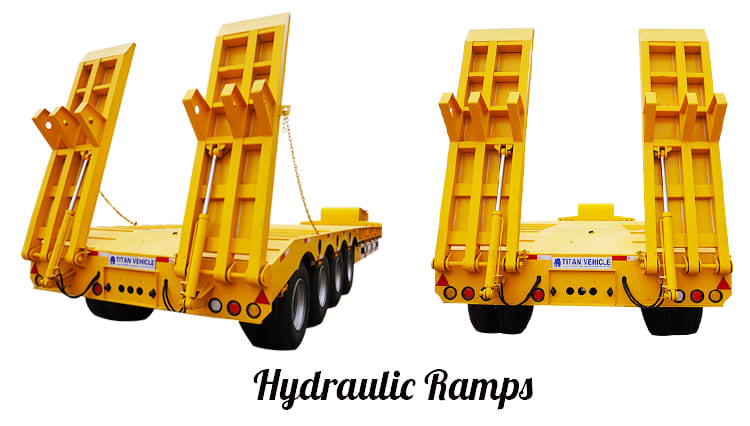
Operation of Low Bed Semi Trailer Hydraulic Ramps
Mastering the operation of low bed semi-trailer ramps is essential for efficient and safe cargo transportation. Whether using hydraulic ramps, spring ramps, or folding ramps, following the recommended procedures ensures the proper deployment and secure loading and unloading of heavy equipment and oversized cargo. By understanding the unique features and operating principles of each ramp type, operators can handle diverse cargo requirements effectively and contribute to a smooth logistics process in the transportation industry.